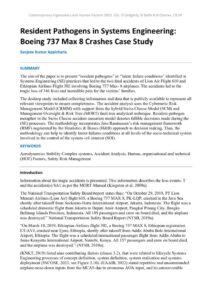| Document | Author Sanjeev Kumar Appicharla |
| Abstract The aim of the paper is to present “resident pathogens” or “latent failure conditions” identified in Systems Engineering (SE) practices that led to the two fatal accidents of Lion Air Flight 610 and Ethiopian Airlines Flight 302 involving Boeing 737 Max- 8 airplanes. The accidents led to the tragic loss of 346 lives and incredible pain for the victims’ families. The desktop study included collecting information and data that is publicly available to represent all relevant viewpoints to ensure completeness. The accident analysis uses the Cybernetic Risk Management Model (CRMM) with support from the hybrid Swiss Cheese Model (SCM) and Management Oversight & Risk Tree (MORT) fault tree analytical technique. Resident pathogen metaphor in the Swiss Cheese accident causation model denotes fallible decisions made during the (SE) processes. The methodology incorporates Jens Rasmussen’s risk management framework (RMF) augmented by the Heuristics & Biases (H&B) approach to decision making, Thus, the methodology can help to identify latent failures conditions at all levels of the socio-technical system involved in the control of the system -of- interest (SOI). |

